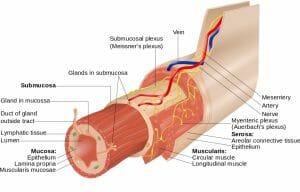Lamina Propria Definition
The lamina propria is one of three layers which make up the mucosa, or mucous membrane. The lamina propria is a large layer of connective tissue which separates the innermost layer of epithelial cells from a layer of smooth muscle tissue called the muscularis mucosa. This can be seen in the image below, of a small intestine. The lamina propria is labeled on the bottom left.
Mucous membranes line various organs and body cavities which have access to the outside, such as the lungs, intestines, and stomach. There are also mucous membranes in the nose, mouth, and on the tongue. The lamina propria serves several functions in these membranes, from holding the epithelial cells together to allowing the passage of blood vessels and nutrients. The lamina propria also serves as an important physical barrier which stops unwanted materials and organisms from gaining access to the body.
Lamina Propria Structure
The lamina propria varies in chemical composition from animal to animal, and from organ to organ. In general, the lamina propria is a complex mesh of extracellular proteins and structural molecules. These molecules include collagen, a standard animal structural protein, as well as laminins, perlecan, and entactin. These molecules form complex sheets which can be layered to form the thick lamina propria.
Each organ has a specific purpose, and therefore a different configuration of the mucosa which covers the organ. For instance, the mucosa layer of the lungs is responsible for diffusing large amounts of gases to and from the blood vessels. Therefore, the lamina propria of the lungs is arranged around and between these vessels, providing maximum surface area. In the intestines, there is less of a need gas exchange. Instead, the lamina propria is modified to allow the passage of a large number of ducts, which connect to the liver, pancreas and salivary glands. These ducts allow the passage of materials needed for digestion.
Lamina Propria Function
The lamina propria has several functions. The first and most basic is to connect the innermost epithelial cells of organs with the smooth muscle layer which defines a mucous membrane. The molecules within the lamina propria act as a series of chains and hooks, to lock the cells and membrane into place. Then, when the muscular layer of the mucosa contracts, the lamina propria functions to transfer that force to the epithelial cells. In this way, the body can force the mucous membranes to change shape, and can cause vessels and the gastrointestinal tract to squeeze or relax.
Besides these obvious physical functions, the lamina propria has an important immune function. Because the layer is created by a complex arrangement of structural molecules, there is very little room for bacteria, viruses, and general debris to make their way into the cells or bloodstream. Further, immune cells can travel within the lamina propria, to seek out and destroy invading pathogens. As there is nearly 200 times the amount of mucosa in the human body compared to the amount of skin, the lamina propria is the largest protective barrier of the body.
Quiz
1. Which of the following is NOT an element of the mucous membrane?
A. Lamina propria
B. Blood cells
C. Epithelium
2. Which of the following best describes the function of the lamina propria?
A. Provides support of the epithelium, and provides a physical barrier against pathogens
B. Holds muscles together
C. Helps contract muscles and vessels
3. The mucous membranes in the throat are relatively smooth, while the mucous membranes in the intestines are rough. The lamina propria in the intestines has many folds, which create the rough surface. Why are the two membranes different?
A. The throat needs to be smooth to swallow
B. The gut is rough to grind nutrients
C. The throat does not absorb nutrients, while the intestines do
References
- Lodish, H., Berk, A., Kaiser, C. A., Krieger, M., Scott, M. P., Bretscher, A., . . . Matsudaira, P. (2008). Molecular Cell Biology (6th ed.). New York: W.H. Freeman and Company.
- Nelson, D. L., & Cox, M. M. (2008). Principles of Biochemistry. New York: W.H. Freeman and Company.
- Widmaier, E. P., Raff, H., & Strang, K. T. (2008). Vander’s Human Physiology: The Mechanisms of Body Function (11th ed.). Boston: McGraw-Hill Higher Education.
Lamina Propria

No comments:
Post a Comment